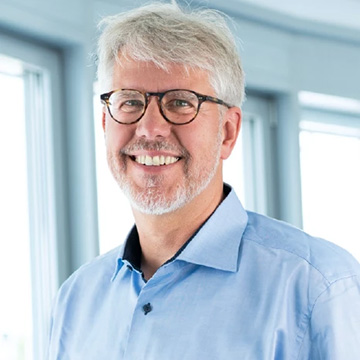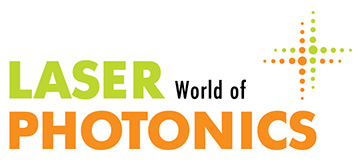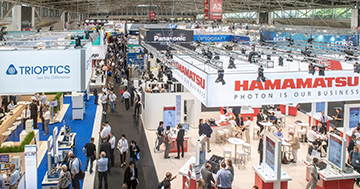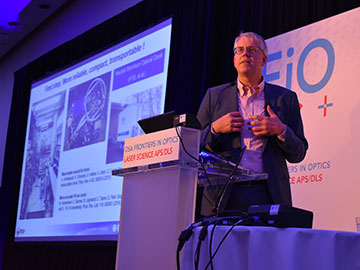
Wilhelm Kaenders. [Image: TOPTICA Photonics AG]
This year, the international trade fair LASER World of Photonics—taking place in Munich, Germany, from 27 to 30 June—celebrates its 50th anniversary. OPN recently caught up with Wilhelm Kaenders, the cofounder and CTO of TOPTICA Photonics and the chair of the LASER show’s industrial advisory board, to talk about the 2023 edition of the conference. Coincidentally, Kaenders’ own firm is celebrating its own 25th anniversary this year, and he also offered some thoughts on the company’s journey and the future of the photonics business.
LASER World of Photonics began exactly 50 years ago as “LASER 73.” In the spirit of that anniversary, I was wondering if you could tell us a bit about the first time you attended—where you were at that point in your career, and what your impressions were at the time.
Wilhelm Kaenders: I personally came into contact with LASER for the first time in 1995, when I started working with Technolas/TUI Laser as the head of their new diode laser group. The management at the time offered me a total of DM50,000 [around US$35,000 at then-current exchange rates] for my salary and needed equipment, to demonstrate the value of my ideas at LASER Munich, directly at the show ground.
I had only three months to generate a sellable copy of my Ph.D. laser and to prepare to demonstrate Rb-saturation spectroscopy on the show floor. Unfortunately, we were given a very windy place at one of the show entrances. But, together with a very good friend and colleague of my Ph.D. days, over many long nights we mastered this task sufficiently well to get more funding and support after this. And that eventually led to the founding of TUIOPTICS—later renamed TOPTICA—in 1998.
Today you’re heavily involved with the LASER show, for which you have served since 2009 as the chair of the industrial advisory board. What does that role involve?
LASER World of Photonics to me is a continuous process, reflecting the pulse of an ever-emerging industry. When I got into the chair role, being a representative of a small company at the time, I was baffled by the opportunity to act among other industry giants like Trumpf, Coherent, Spectra Physics, Rofin et al.
“LASER World of Photonics to me is a continuous process, reflecting the pulse of an ever-emerging industry.”—Wilhelm Kaenders
Over time, however, as TOPTICA evolved as a company, and as I saw consolidation happen in the industry, the idea my acting as a representative voice for the industry as a whole felt more real to me—in particular as TOPTICA as a company was able to grow and stay independent, even as others have gone through various transitions, with their representations changing.
The board acts as an input channel and resonance board to the show managers at Messe München—which themselves are, of course, not as close to our industry and its dynamics.
For many trade shows and scientific meetings, COVID-19 was obviously a big disrupter. How has the experience been at LASER?
COVID was a big hit not only for the LASER event, but also for the fairground organizer, Messegesellschaft München. It led to drastic reorganizations not only for the local event in Munich but also for the Chinese and Indian versions of LASER.

[Image: Messe München]
There were compromises to make—like splitting the conference program off the show for one year, adjusting the biannual schedule and so on. Worst of all was the uncertainty about when these special circumstances would come to an end and when regular business could be resumed. Luckily, the economic hit from COVID to the laser industry as a whole was very moderate. It was more that the side effects, like the supply chain crisis and the shortage of qualified workforce, were the impediments and holding us of from even stronger growth opportunities.
One interesting aspect of LASER this year is that it will be co-located with automatica, a leading exhibition for fields such as smart automation and robotics. What are some of the benefits of co-location with that meeting?
The laser field has now more than 60 years under its belt. We are today, by far, not “a solution looking for a problem” anymore! Instead, new challenges come looking for a laser solution every year. And automation is a big one.
Automation is partly about using the nondestructive nature of light for sensing, identification, inspection, control, and so on. I think the joint topics of both events—LASER and automatica—can be beautifully aligned with the modifying features that laser light also has to offer for cutting, welding, annealing, structuring, etc. Having both shows co-located brings two industries together that will continue to benefit greatly from each other.
Another co-located meeting will be the World of Quantum, which debuted last year.
Yes, and that too is a natural pairing. The quantum field is strongly driven by the decades of insights generated in quantum optics—which I take to mean the understanding of quantum phenomena with photons. In general, many former pure gedankenexperimente [thought experiments] could be realized for the first time and an understanding of quantum statistical properties could be generated.
What are you personally looking forward to at this year’s LASER?

The show floor at LASER World of Photonics. [Image: Messe München]
The convergence of light-driven insights to applications—in research, industry and applications—has been and will remain the foothold for our thriving industry. The field has not seen any recession over the last few years despite COVID, and the order books are still full. Many companies, including TOPTICA, were struck more by the supply-chain crisis and by the shortage of technical hires than by a lack of market interest. We continue to see huge government investments in our field also.
So I am confident that neither demand nor innovation has been throttled. The latest edition of the Innovation Award that will be presented at LASER Munich will be documenting the speed of innovation. I am quite looking forward to that part of the program also.
You mentioned TOPTICA Photonics, the firm you cofounded. Like the LASER show, TOPTICA, too, is celebrating a significant anniversary—it turned 25 years old in February of this year. How did you come to make the transition into this industry venture?
Initially, I intended that my employment with the TOPTICA’s precursor company, TUI Laser, would serve as my personal “time bridge” between my Ph.D. and, potentially, another academic role. However, I found that I loved the opportunity of personal engagement and long-term ownership that the TOPTICA project allowed. I had no problem at all supporting my colleagues in my former academic field of interest—now as a supplier rather than as a researcher; I have even enjoyed it since.
“I loved the opportunity of personal engagement and long-term ownership that the TOPTICA project allowed.”—Wilhelm Kaenders
The continued and steady growth of TOPTICA have brought sufficient challenges to keep me interested long term. And the “bootstrap” nature of it kept us (and our families), as founders, from needing to stick our necks out too much in the sense of financial risk.
TOPTICA has gone from a small startup to an international firm with hundreds of employees and covering a wide-range of laser technologies. What are some of the biggest lessons you’ve learned in the course of that journey?
There were multiple phases of growth we had to go through—for example, when we passed the 30- or 100-employees company size. Now, with close to 500 employees and a growing global direct presence, we are facing new challenges.
With a larger company we have had to take a more organized approach to innovation, something unheard of for us in the beginning. And what I regret about that, on a personal level, is the loss, as the company grew, of the insight of good friends whose personalities were made for a startup but who were not a good fit for the more organized and distributed responsibility in a larger organization.
Maintaining, as much as possible, a creative and family atmosphere is the biggest ambition that my colleague Thomas Renner and I continue to have for the organization. Only when our employees enjoy coming to work at least nine of every ten days can we feel we have done our job well.

[Image: TOPTICA Photonics AG]
Across its 25 years of history, what events, business decisions or other milestones have been particularly important in shaping the TOPTICA of today?
Well, we have always had more opportunities and ambitions then we could reasonably pursue. As part of our starting philosophy, we strived to have a fair balance between research and industrial markets. In the beginning that meant activity in the field of optical data storage, where we had the unique opportunity to commercialize an academic development—a static and dynamic tester for the next generation of optical data storage. That was a huge challenge at the time, as the DVD era was coming to an end and everybody was preparing for the third generation of optical or magnetically assisted data storage.
To cut a long story short, this endeavor produced tunable blue diode lasers and a battle between two novel data storage formats—HD-DVD and Bluray. And TOPTICA suddenly found itself in the middle of that. While for us it wasn’t commercially the biggest win, it led to a highly qualified electronics R&D team in our company, a close early partnership with Sony and Nichia, and a big professional boost for us in other projects, like lasers for the semiconductor industry and life science, in particular microscopy.
Commercially, we discontinued the disk tester product line soon. But the resulting boost into the company genes is still the core of our high-end, low-noise digital laser driver and controller philosophy.
TOPTICA today operates in a worldwide market. How does TOPTICA approach identifying global opportunities?
Indeed, we have needed to approach, and have been approaching, our markets globally from the start. Historically that has been unheard of, and it would have been impossible to do without emerging communication made possible by the internet, and without a tightly interwoven international research community as a customer base.
“We have needed to approach, and have been approaching, our markets globally from the start.”—Wilhelm Kaenders
Coming from the Ted Hänsch environment (Nobel laureate in 2005), I always felt welcomed and respected in the US, Indian and Chinese academic communities. Our ambition was, and is, to provide value to our academic customers by providing leading tools. More than 14 Nobel Prize winners have used or are using our lasers in fields ranging from fundamental research in quantum, to biology, to astronomy.
To convert scientific excellence into sound products for industrial markets remains a challenge for technical and market reasons. It is all about driving the reliability up and the cost down, but also to enable volume scaling.
Let’s talk for a few minutes about the future of the laser business, and about where TOPTICA is headed in its next 25 years. As you survey the landscape today, what do you see as the “megatrends” or big ideas that are going to drive the laser business in the coming decade?
People more knowledgeable than I am have pointed out that our visual system—the human eye—is the key to understanding the world. To me, that means, for the future, more and more light and photonics, but also more sophistication down to the individual photon level.

Wilhelm Kaenders giving a “Visionary Speakers” talk on quantum science and business at FiO 2017. [Image: OPN]
Our field has solutions to offer for challenges in energy, in the form of photovoltaics and LEDs; for communications (the internet backbone is optical); for modern manufacturing (cutting, welding, cold ablation). High-end optical lithography is driving Moore’s law, but also new forms optical quantum computing are emerging, where the photon has become a “flying qubit.” Of course, the concepts will be more general, and microwave and X-ray spectral domains will be added to the realm of photonics.
There’s also, of course, “Industry 4.0,” and the continued move to smart factories and industrial automation.
Yes. Currently, as a company, TOPTICA provides digital control of all our laser instruments and offers state-of-the-art software development kits for high level integration, but we have not looked more broadly at this area yet. We are aware of the ambitions and needs of a more digitally controlled industry, of course, and do admire the advances made by the big industry integrators and providers.
Another “big idea” for photonics, which you briefly alluded to, has been quantum technology. How do you see the opportunities opening up there?
Coming myself from the cold-atom and quantum-optics background, I am very happy to see the current evolution of interests and opportunities. I admit that I’m sometimes shocked by bold claims made to impress the public and funders and maybe repeated too naively by politicians. But I believe that the quantum frontier is a good one to be involved with. Bringing engineers and physicists together is not that easy—but, in my view, it’s a great recipe for success.
Are there any final thoughts you’d like to share on the future of this business?
“We are—by far—not at the end of our understanding and utilization of the photon ... It’s going to stay exciting.”—Wilhelm Kaenders
We are—by far—not at the end of our understanding and utilization of the photon. Young people have such great opportunities to grow the field, and to grow professionally themselves, over the next decades, and at the same time to contribute to a better world. There is no way back, but only a path forward. It’s going to stay exciting.
We are already looking forward to 2025, when LASER World of Photonics and the World of Photonics Congress will return to Munich. The next event will run from 24 to 27 June 2025.

